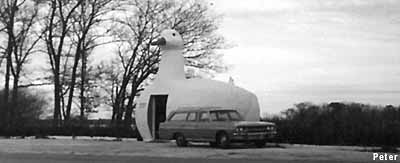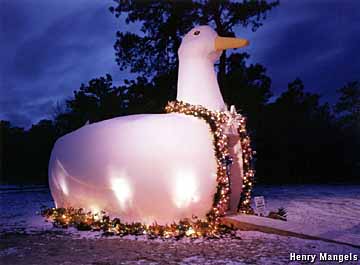LONG ISLAND DUCK
The cache is not at the posted coordinates. The Big Duck of Long Island is a classic example of "duck architecture" and has become a favorite roadside attraction for both Long Islanders and those tourists visiting Long Island.
The Big Duck
The people of Long Island love the Big Duck -- or so we've been told. The odd-shaped building, on the Island's east end near the Hamptons, is one of the few examples of roadside architecture within driving distance of New York City vacationers. Hence all the attention the Duck gets in any book or article written about wacky structures along America's highways.
In 1931, Riverhead duck farmer Martin Maurer commissioned some local builders to create this 10-ton eye-catcher using concrete (technically, "ferrocement") applied over a wooden frame. Taillights from a Model T Ford became its eyes, glowing red at night. Maurer sold ducks and eggs from the shop in its belly.

Maurer drew his inspiration from odd structures he had seen in California, especially a building shaped like a giant coffee pot. Shrewdly, Maurer patented his fowl creation, and the Duck became the darling of vacationing New Yorkers -- particularly husband and wife architects Robert Venturi and Denise Scott Brown, who invented the term "duck architecture" in their 1972 book, Learning From Las Vegas. This explain why, in the world of architecture, any building shaped like its product is called a "duck." Not a "coffee pot."

Big Duck at Christmas time.
Maurer is long dead, and the Big Duck -- 30 feet long, 20 feet high, and 18 feet wide -- has shifted locale a few times. In the 1980s, when the land on which the Duck sat was earmarked for development, giant duck preservationists and the Friends for Long Island's Heritage campaigned to save it. The Duck was donated to the county. On January 27, 1988, it was moved from Flanders to Hampton Bay along Route 24, to the entrance of Sears-Bellow County Park. However, by 2007 it was clear that the original land would not be developed, so the Big Duck was moved four miles back to its Flanders spot.
The shop still operates -- now as a tourism center for the East end of Long Island, selling duck souvenirs to flocks of city weekend-trippers. The interior of the Duck offers a small display of Duck artifacts, photos, and news clippings, and if you time your visit just right you'll find a volunteer manning an exhibit in an adjacent barn about duck farming. The Big Duck itself remains a steady draw.
Each year, (the first Wednesday in December) the Suffolk County Parks Department sponsors the Annual Holiday Lighting of the Big Duck the first Wednesday after Thanksgiving. Local school children sing "Duck" carols, and warm refreshments including hot chocolate, cookies and doughnuts are served. Visitors join in singing the duck carols while awaiting the arrival of Santa Claus, transported by the Flanders Fire Department. Once Santa arrives, the switch is flipped and the Big Duck lights up for all to see.
The cache can be found at N40 44.ABC W073 35.DEF
- In 19C1, Riverhead duck farmer Martin Maurer commissioned some local builders to create this 1B-ton eye-catcher using concrete (technically, "ferrocement") applied over a wooden frame.
- On January 27, 1A88, it was moved from Flanders to Hampton Bay along Route 24, to the entrance of Sears-Bellow County Park.
- Maurer is long dead, and the Big Duck -- 3D feet long, 2E feet high, and 18 feet wide -- has shifted locale a few times.
- However, by 20F7 it was clear that the original land would not be developed, so the Big Duck was moved four miles back to its Flanders spot.